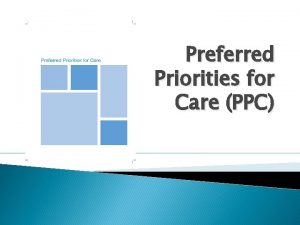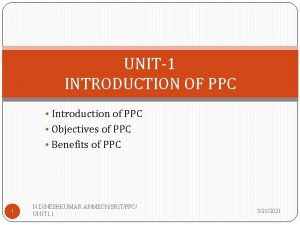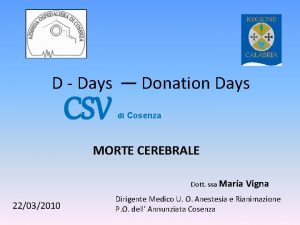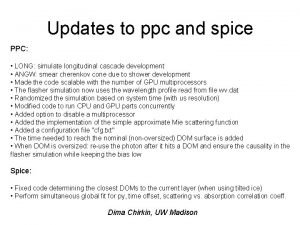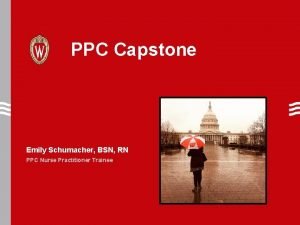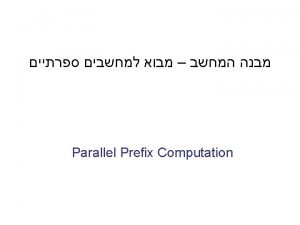Preferred Priorities for Care PPC Preferred Priorities for














- Slides: 14

Preferred Priorities for Care (PPC)

Preferred Priorities for Care (PPC) • • Formerly known as Preferred Place of Care Lancashire and South Cumbria Cancer Network. Originally patient-held form for people living in the community with a cancer diagnosis Focus on where people wanted to be cared for at the end of their lives. Now Preferred Priorities for Care. Focus on wider priorities than place of care Preferences, values and wishes also important Supported by NHS End of Life Care programme as an example of an advance care plan.

Potential triggers for PPC Personal choice Following life changing event Following diagnosis of a life limiting illness During assessment of a persons need Following a significant shift in treatment In conjunction with prognostic indicators Multiple hospital admissions Admission to a care home

It should be. . . Entirely voluntary not forced A continuous process and not ‘task and finish’ Person led not professional led Aim to manage expectations not raise them Inclusive of the family where appropriate Communicated to others with permission (NWAS, OOH, GP) Reviewed and updated regularly as dictated by the client or as the result of a significant event i. e. Hospital admission Kept in a visible & accessible place

Starting PPC Conversations �P – Prepare for discussion/ environment/time � R – Relate to the person/ Am I the right person? � E – Elicit client preferences, beliefs/ cues � P – Provide information/ informed decisions � A – Acknowledge emotions and concerns � R – Realistic hope/ manage expectations � E – Encourage questions/ allow reflection � D – Document

What to talk about? Person’s agenda; What are the persons feelings about their illness, what concerns do they have, what goals are they looking to reach, do they understand their illness and its prognosis, do they have particular care preferences, now and in the future? Tools that may help trigger conversations; • Thinking about it! Prompt card • Notice board • Conversations for life cards • Dying Matters Resources/ Events • Reminiscence groups/ memory boxes

Who completes the documentation? Patient held document Ideally patient Could be a relative with patients input Could be professional with patient Potentially an individual with LPA for health & welfare could fill in for a patient.

Recording preferences The explicit recording of patients/carers wishes can form the basis of care planning in multi-disciplinary teams and other services, minimising inappropriate admissions and interventions. In relation to your health what has been happening to you? What are your preferences and priorities for your future care? Where would you like to be cared for in the future?

Challenges of using PPC • • • Challenging and sometimes complex conversations No hiding from the ‘End of Life’ conversation Family conflict and coercion Potential for increased burden on the family Managing expectations Goal posts will often move

Supporting Resources: Poster • Illustrates a uniform approach underpinning the culture of the organisation • Individuals are less threatened and suspicious of rationale • Delivers a consistent message • Triggers conversations

Supporting Resources: Leaflet • Illustrates a collaborative approach with national initiatives • Allows personal space for consideration • Delivers a consistent message • Supports conversations

Supporting Resources: Factsheet • Provides guidance for people using the PPC • Additional information for clients and family

Supporting Resources: Easy Read • Version for use with clients who have communication difficulties i. e. Learning disabilities, dementia

Any Questions? Contact your Macmillan Team or the End of Life Care Team Bespoke training is available on request Thank you for taking the time to view this presentation
 Preferred priorities for care
Preferred priorities for care Well-behaved preferences
Well-behaved preferences Primary secondary and tertiary health care
Primary secondary and tertiary health care Outward shift in ppc
Outward shift in ppc Nvidia ppc
Nvidia ppc Ppc search engine marketing positioning
Ppc search engine marketing positioning Objectives of ppc
Objectives of ppc 3 shifters of ppc
3 shifters of ppc Ppc curve economic growth
Ppc curve economic growth Ppc in economics
Ppc in economics Agentie retargeting
Agentie retargeting Ppc=pam-pic
Ppc=pam-pic Pam-pic
Pam-pic Mrporteer
Mrporteer Gopresto/ppc/rocking
Gopresto/ppc/rocking
